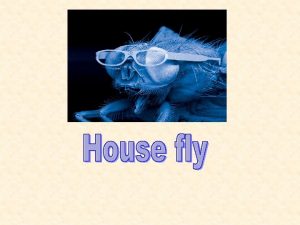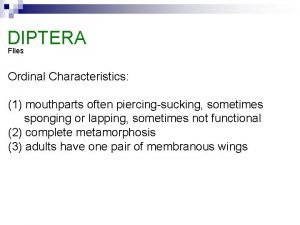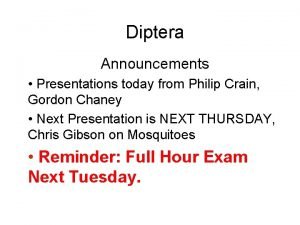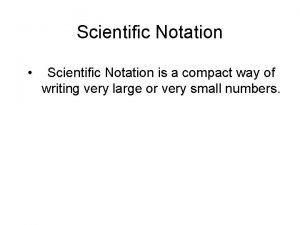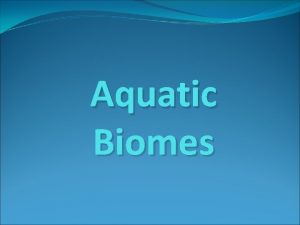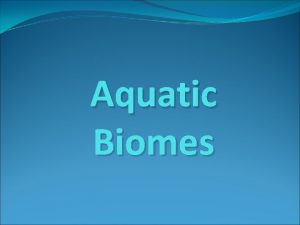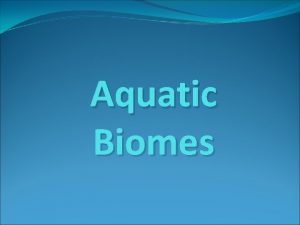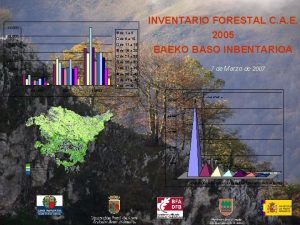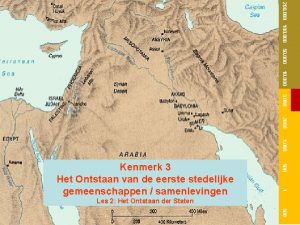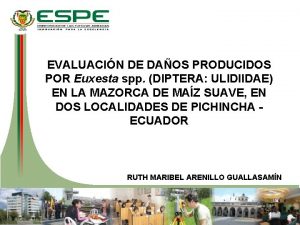Aquatic Diptera Diptera flies Almost 120 000 spp

























- Slides: 25

Aquatic Diptera

Diptera "flies“ �Almost 120, 000 spp. worldwide � 51, 197 spp. worldwide are aquatic or semiaquatic � 17, 000 spp. in 2, 222 genn. in 108 famm. in North America � 6, 081+ spp. in 495 genn. in 30 famm. in North America are aquatic or semiaquatic

Pest Diptera �Over 50% of world's population presently infected with diseases carried by flies �Much of human history has been affected by the role of flies in disease transmission, both in determining the outcomes of war and in retarding economic development. �Also, flies cause considerable crop loss each year both in the field and in storage.

Beneficial Diptera �Dipterous parasites and predators rank with Hymenoptera in controlling pest insects �Role of flies in detritus processing exceeded only by bacteria and fungi �In aquatic ecosystems, flies often play a key role in food webs.

Diagnosis of Fly Adults �Adults: Winged adults always with one pair of wings on the mesothorax, and a pair of halters on the metathorax �di = two, ptera = wings

Diagnosis of Fly Larvae (maggots) � Never with segmented legs, although fleshy prolegs sometimes present � Head may be fully developed, fully developed but retracted into thorax, partially developed (whether retracted or not), or with only a few tiny sclerites (the most conspicuous of which are mouth hooks) � May have posterior breathing tube (sometimes telescoping) and/or anal papillae or filamentous gills � apneustic (without spiracles) � metapneustic (with only caudal spiracles) � amphipneustic (with prothoracic and caudal spiracles)

Diagnosis of Fly Pupae �Generally exarate with prothoracic spiracular gills or �Enclosed in puparium (modified and hardened final larval exuviae)

Diptera Habitats �All Diptera are aquatic in the broadest sense, requiring a humid environment for development �Most Nematocera and several Brachycera eggs, larvae, and pupae develop only when submerged in wet environments �These insects live in almost every type of aquatic habitat, including coastal marine and brackish waters and brine pools; shallow and deep lakes; ponds; geyser pools up to 49øC; natural seeps of crude petroleum; stagnant or temporary pools and puddles; water in bromeliads and pitcher plants and in artificial containers; slow to fast flowing streams and rivers.

Diptera Habits �Planktonic �Clinging �Sprawling �Burrowing

Diptera Trophic Relationships �All of Merritt et al. ’s (2008, Table 6 C, page 108) categories except piercing plants: �Shredders-herbivores, -detritivores, -gougers �Collectors-filterers, -gatherers �Scrapers �Predators-engulfers –piercers �Parasites

Suborder Nematocera Larva �Well-sclerotized head fully exposed (except Tipulidae, with head retracted into thorax and often sclerotized only in long slender rods) �Mandibles opposed, moving horizontally

Suborder Nematocera Adult �With long antennae, composed of 6 or more freely articulated segments

INFRAORDER TIPULOMORPHA Superfamily Tipuloidea Family Tipulidae (crane flies, leather. Jackets) �Head capsule incomplete posteriorly, withdrawn into thorax �larvae of most spp. metapneustic, requiring occasional return to air �Nearly 1, 600 spp. of aquatic or semiaquatic crane flies in North America, world-wide the largest family of flies.

Tipulidae (continued) �Generally lentic-littoral, lotic-erosional and depositional -- Spp. in the family are aquatic, semiaquatic, or live in decaying vegetation, under bark, in fungi, or feed on leaves or roots of forage crops or seedling field crops �Most pupae and all adults are terrestrial �Mostly shredders-detritivores and collectors-gatherers, few shredders-herbivores and predators �Generally burrowers, sometimes also sprawlers or clingers; Antocha is unusual -- a clinger in a silken tube in lotic erosional habitats

Tipulidae Crane Flies Long legs V-shaped suture on mesonotum

Very Good Crane Fly Website http: //iz. carnegiemnh. org/cranefly

Family Simuliidae (black flies) � Caudal circle of tiny hooks � Filtering fans on head � Lotic-erosional � Clingers � Collectors-filterers � Pupae usually in slipper-shaped cocoons open downstream from which opening the branched spiracular gills trail in the water � Females of several spp. require vertebrate blood meal for ovarial development � Some spp. carry filarial nematode parasites of vertebrates, most serious of which is Onchocerca volvulus of tropical Africa ("river blindness" or "onchocerciasis")

Simuliidae Humped back Broad wings Anterior veins strong, posterior veins weak Short antennae

Excellent Resource Adler, P. H. , D. C. Currie, and D. M. Wood. 2004. The black flies (Simuliidae) of North America. Cornell University Press, Ithaca, NY. 941 pp. + 24 color plates.

Family Chironomidae (midges) �Apneustic �With paired prothoracic and/or anal prolegs �Various spp. occur in virtually all freshwater habitats, including marine habitats, springs, and tree holes �Burrowers or clingers (mostly tube builders), sprawlers, rarely climbers �Usually either collectorsgatherers and -filterers and scrapers or predators (engulfers or piercers)

Chironomidae (continued) �Most important family of aquatic insects in terms of species diversity, biomass, and ecosystem energy processing �Llife cycles may be completed in 2 weeks to several years, generally 1 or 2 generations per year � 1 st instar planktonic and often quite different from later instars in morphology; 2 nd - 4 th instars and pupa benthic; pupa swims to surface to emerge; adults live a few days, may take liquid carbohydrates such as aphid honeydew and flower nectar; eggs broadcast over the water or laid on the surface or on vegetation �Pupae generally more readily diagnostic than larvae

Chironomidae non-biting midges Male antennae plumose Postnotum usually with longitudinal groove

Best Key for Carolinas Midges Epler, J. "Identification Manual for the Larval Chironomidae (Diptera) of North and South Carolina, ” pdf at http: //www. esb. enr. state. nc. us/BAUwww/Chironomid. htm

Family Athericidae (watersnipe flies) �Head retracted, anterior end tapered �Paired spiny prolegs on each abdominal segment (except unpaired on last segment) �Very distinctive fringed terminal filaments posteriorly �Lotic-erosional (mostly) or -depositional (usually cold mountain streams) �Sprawlers and burrowers �Predators-piercers �Atherix lanthus is the only eastern N. Amer. sp.

Athericidae 3 -segmented antennae Veins equally strong Costal vein continuing around wing tip
 602 200 000 000 000 000 000 000 in scientific notation
602 200 000 000 000 000 000 000 in scientific notation 97 700 000 000 000 000 000 000 in scientific notation
97 700 000 000 000 000 000 000 in scientific notation 71 000 in scientific notation
71 000 in scientific notation 0,000 0,000 0,000
0,000 0,000 0,000 120/100*80
120/100*80 120px x 120px
120px x 120px Diptera
Diptera Antenas aristadas
Antenas aristadas Characteristics of diptera
Characteristics of diptera Diptera characteristics
Diptera characteristics An asset was purchased for $120 000 on january 1
An asset was purchased for $120 000 on january 1 Time flies like arrow fruit flies like banana
Time flies like arrow fruit flies like banana Notation express
Notation express 4 500 000
4 500 000 1 000 000 0000
1 000 000 0000 Express 4,980,000, 000 in scientific notation
Express 4,980,000, 000 in scientific notation 1 600 000
1 600 000 100,1000,10000
100,1000,10000 1 200 000 000
1 200 000 000 4 500 000
4 500 000 Micro nano pico
Micro nano pico What is 140 000 000 in scientific notation
What is 140 000 000 in scientific notation 1,000 x 3,000
1,000 x 3,000 What are some of the advantages of scientific notation?
What are some of the advantages of scientific notation? 60 000 000
60 000 000 260 000 000
260 000 000






